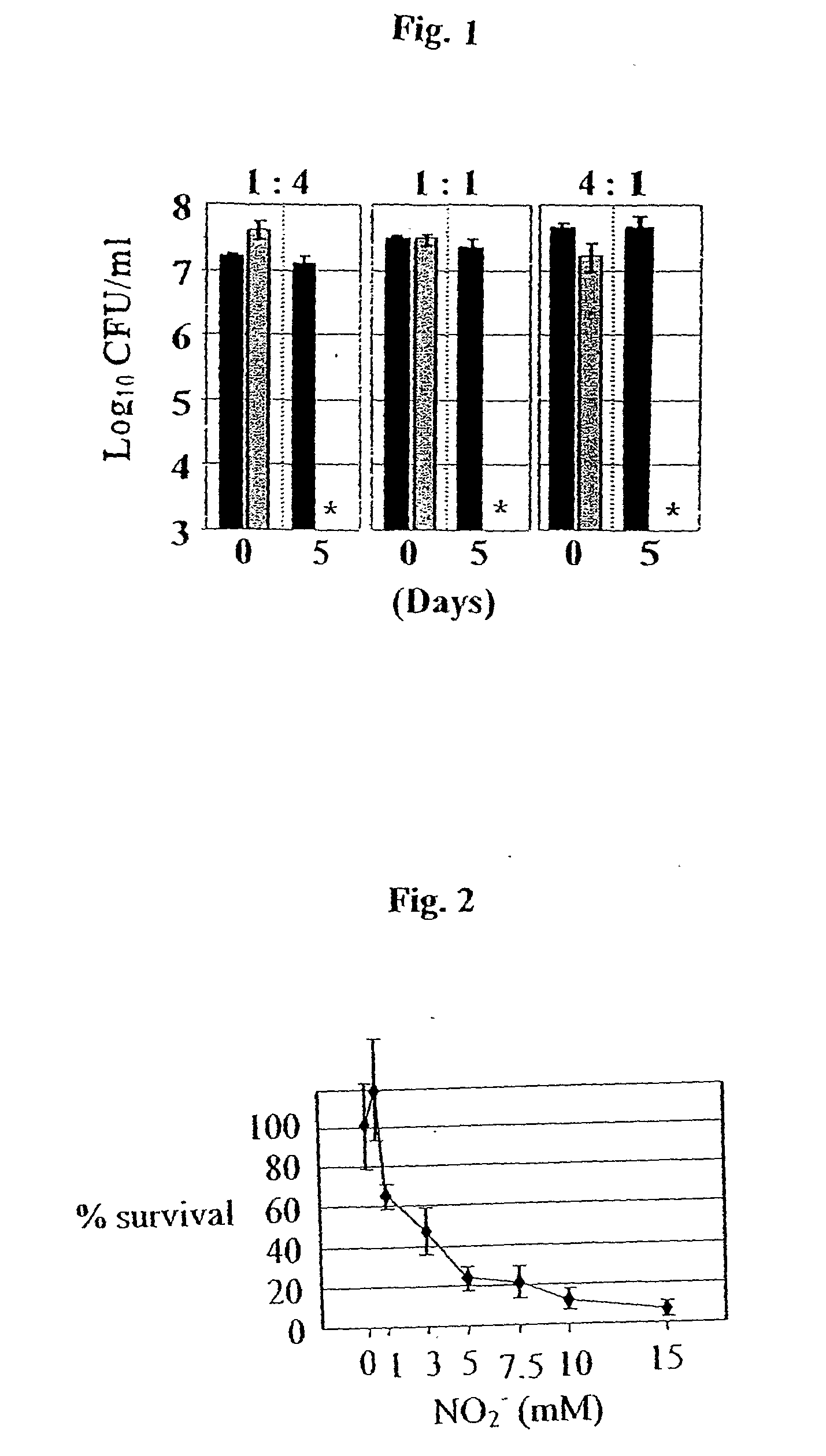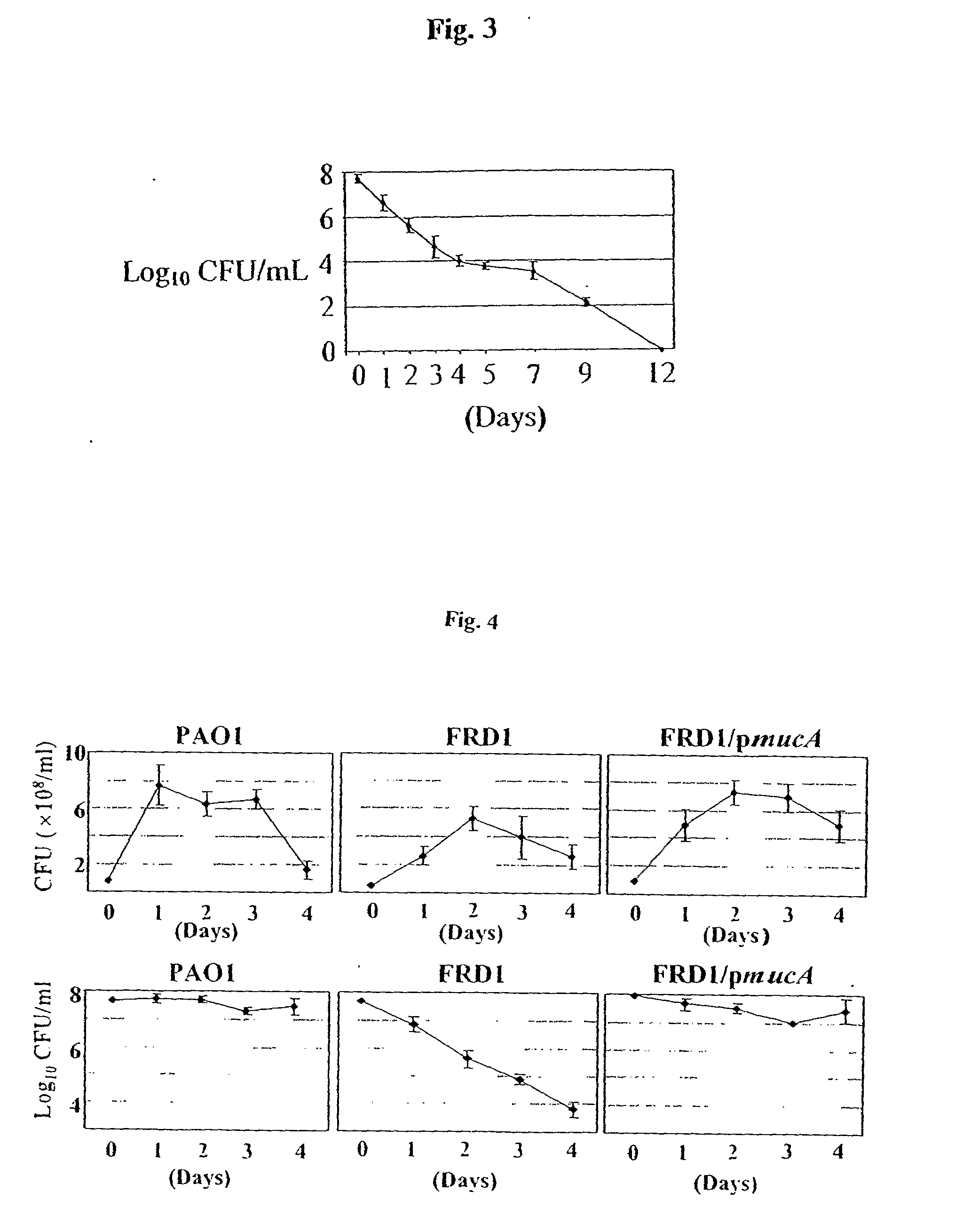Methods for Treating Bacterial Respiratory Tract Infections in an Individual Using Acidified Nitrite
a technology of bacterial respiratory tract infection and acidified nitrite, which is applied in the direction of biocide, antibacterial agents, aerosol delivery, etc., can solve the problems of morbidity and mortality associated with the disease, the loss of function of these organs, and the difficult treatment of both healthy and sick individuals
- Summary
- Abstract
- Description
- Claims
- Application Information
AI Technical Summary
Benefits of technology
Problems solved by technology
Method used
Image
Examples
example 1
[0078]This example shows NO2− as an effective treatment for mucoid PA infections in in vitro anaerobic biofilms and fresh sputum isolates from CF patients.
[0079]To explore the potential clinical application of HNO2 in the treatment of mucoid PA infections in chronic CF patients, the effect of NO2− on the viability of biofilm bacteria is tested. Anaerobic biofilms of strains FRD1 and FRD1 / pmucA are grown for 1 day in media containing NO3−, which supports anaerobic respiration. Since mucoid strain FRD1 lacks a flagellum, a surface appendage that is critical for PA biofilm initiation, strain FRD1 forms much weaker biofilms compared to those of flagellated FRD1 / pmucA (FIG. 12 vs. FIG. 13). When the FRD1 biofilm is treated with NO2− at pH 7.5 for 2 days, no difference in biofilm structure and cell viability is observed relative to control biofilms. In contrast, nearly complete death of biofilm organisms is observed after a 2-day incubation with NO2− at pH 6.5 (FIG. 12). In biofilms of FR...
example 2
[0081]This example shows HNO2 kills mucoid PA in a sterile ultrasupernatant derived from explanted CF lungs and in mouse airways.
[0082]Next, it is determined whether mucoid strain FRD1 can be killed by HNO2 in sterile ultrasupernatants (pH 6.24) of CF airway secretions derived from explanted CF lungs. This reagent arguably represents the best medium to investigate PA in the context of bacterial growth and the effects of HNO2 ex vivo. FIG. 15 shows that mucoid bacteria are actually killed faster by HNO2 in the CF ultrasupernatants than in L-broth (refer to FIG. 4).
[0083]Next, NO levels generated from HNO2 disproportionation in ASL is collected from primary CF airway epithelia and measured. FIG. 16 indicates that NO, at levels even greater (562 nM) than those generated in LB at pH 6.5 (489 nM, refer to FIG. 8), is produced in CF ASL. The higher levels of NO produced upon addition of NO2− in this milieu are due to the lower pH of the sample (6.43 vs. 6.5).
[0084]The efficacy of HNO2 to ...
example 3
[0087]This example shows that NO2− does not elicit any adverse effects on airway epithelia in vitro.
[0088]The clinical utility of NO2− as a treatment would be diminished if it exerted significant toxic or adverse effects on airway epithelia. Therefore, the effect of NO2− on cell viability and function of cultured airway epithelia is tested. Further, since NO2− could elicit a pro-inflammatory response that would be undesirable in the CF airways, and NO has been reported to increase IL-8 gene transcription in a lung epithelial cell line, whether NO2− induces IL-8 release from cultured airway epithelia is also tested. Aerosolization, a potential therapeutic delivery route for NO2− to the CF airways, would deliver it in small volumes on the epithelial surface. To mimic this situation in vitro, a low volume (2 μl) of test solution containing various concentrations of NO2− is added to the apical surface of CF airway epithelia at pH 6.5. Exposure to concentrations as high as 20 times the d...
PUM
| Property | Measurement | Unit |
|---|---|---|
| Molar density | aaaaa | aaaaa |
| Fraction | aaaaa | aaaaa |
| Fraction | aaaaa | aaaaa |
Abstract
Description
Claims
Application Information
 Login to View More
Login to View More - R&D
- Intellectual Property
- Life Sciences
- Materials
- Tech Scout
- Unparalleled Data Quality
- Higher Quality Content
- 60% Fewer Hallucinations
Browse by: Latest US Patents, China's latest patents, Technical Efficacy Thesaurus, Application Domain, Technology Topic, Popular Technical Reports.
© 2025 PatSnap. All rights reserved.Legal|Privacy policy|Modern Slavery Act Transparency Statement|Sitemap|About US| Contact US: help@patsnap.com



